Cytomegalovirus infection: symptoms, diagnosis, treatment

Cytomegalovirus infection( CMVI, inclusive cytomegaly) is a very widespread viral disease, usually characterized by a hidden or mild course.
For an adult with normal immunity, the infectious agent does not represent a threat, but it can be fatal to newborns, as well as persons with immunodeficiencies and patients who undergone transplantation.Cytomegalovirus during pregnancy often leads to intrauterine infection of the fetus.
Note: is believed that a prolonged persistence( survival in the body) of the virus is one of the causes of the development of such oncological diseases as mucoepidermoid carcinoma.
Table of contents: Classification Etiology and pathogenesis Symptoms of cytomegalovirus infection Cytomegalovirus in pregnancy Cytomegalovirus infection in children Treatment of cytomegalovirus infectionCMV is found in all regions of the planet.According to statistics, it is present in the body of about 40% of people.Antibodies to the pathogen, indicative of its presence in the body, are found in 20% of children of the first year of life, in 40% of people under the age of 35 and practically in every person from 50 years and older.
Although most infected are latent carriers, the virus is not harmless.Its persistence negatively affects the immune system and, in the long run, often leads to an increased incidence due to reduced reactivity of the body.
It is currently impossible to get rid of cytomegalovirus, but it is possible to minimize its activity to a minimum.
Classification
There is no common generally accepted classification.Congenital cytomegalovirus infection is conventionally divided into acute and chronic forms according to the forms of the current.Acquired CMV can be generalized, acute mononucleosis or latent( without active manifestations).
Etiology and pathogenesis
The causative agent of this opportunistic infection belongs to a family of DNA-containing herpesviruses.

The carrier is a person, i.e. CMV is an anthroponotic disease.The virus is found in the cells of the most diverse glandular tissue-rich organs( the cause of the absence of a specific clinical symptomatology), but most often it is associated with the salivary glands( affects their epithelial cells).
Anthropogenous disease can be transmitted through biological fluids( including saliva, semen, cervical secret).They can get sexually, with a kiss and when using general hygiene items or dishes.With insufficiently high level of hygiene, the fecal-oral route of transmission is not excluded.
From mother to child, cytomegalovirus is transmitted during pregnancy( intrauterine infection) or through breast milk.There is a high probability of infection during transplantation or blood transfusion( blood transfusion), if the donor is a carrier of CMV.
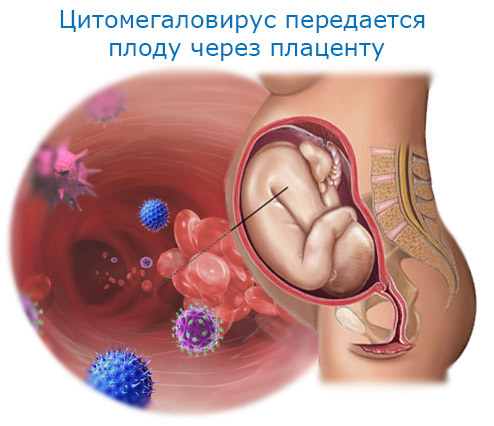
Note : once CMV infection was widely known as a "kissing disease" because it was believed that the disease was transmitted solely through saliva with a kiss.Pathologically altered cells were first discovered during postmortem examination of tissues at the end of the 19th century, and cytomegalovirus itself was isolated only in 1956.
Getting on the mucous membranes, the infectious agent penetrates through them into the blood.Then follows a short period of viremia( the presence of the pathogen of CMVI in the blood), which ends with localization.Target cells for cytomegalovirus are mononuclear phagocytes and leukocytes.In them, the DNA-genomic pathogen replication process takes place.
Once ingested, cytomegalovirus, unfortunately, remains in it until the end of a person's life.The infectious agent is able to multiply actively only in certain cells and under optimally suitable conditions.Thanks to this, with a sufficiently high level of immunity, the virus does not manifest itself.But if the defenses are weakened, cells under the influence of an infectious agent lose the ability to divide, and greatly increase in size, as if swelling( ie, there is actually a cytomegal).DNA-genomic virus( currently open 3 strains) is able to reproduce inside the "host cell" without damaging it.Cytomegalovirus loses activity at high or low temperature and is characterized by relative stability in alkaline environment, but acidic( pH ≤ 3) quickly leads to its death.
Important: Immunosuppression may be a consequence of AIDS, chemotherapy using cytostatics and immunosuppressants for cancer, as well as conventional hypovitaminosis.
In microscopy, it is found that the affected cells have acquired a characteristic appearance of the "owl eye".In them inclusions( inclusions) which are accumulations of viruses are found out.
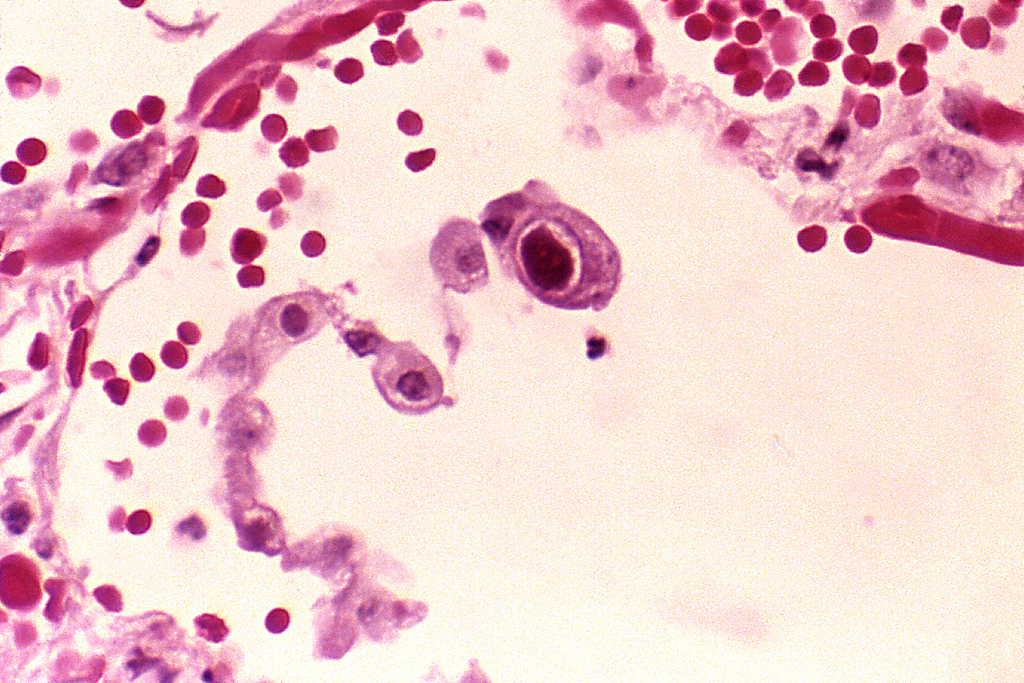
At the tissue level, pathological changes are manifested by the formation of nodular infiltrates and calcifications, the development of fibrosis and the infiltration of tissues with lymphocytes.Special glandular structures can form in the brain.
The virus is resistant to interferons and antibodies.The direct effect on cellular immunity is due to the suppression of T lymphocyte generation.
Symptoms of cytomegalovirus infection
These or other clinical manifestations may occur in the background of primary or secondary immunodeficiencies.
Symptoms of cytomegalovirus infection are non-specific, i.e., the disease can manifest itself differently, depending on which cells are predominantly affected.
In particular, when the mucous membranes of the nose are affected, nasal congestion appears and rhinitis develops.Active reproduction of cytomegalovirus in the cells of the gastrointestinal tract causes diarrhea or constipation;The occurrence of pain or discomfort in the abdominal area and a number of other vague symptoms are also possible.Clinical manifestations of exacerbation of CMVI, as a rule, disappear on their own after a few days.
Note : an active infection can serve as a kind of "indicator" of the insolvency of cellular immunity.
Often the virus can affect the cells of the mucous membranes of the urogenital system.
Cytomegalovirus infection: symptoms in men
In men, reproduction of the virus in the organs of the reproductive system in most cases does not manifest itself in any way, that is, it is an asymptomatic flow.
Cytomegalovirus infection: symptoms in women
In women, CMV infection is manifested by inflammatory diseases of the genital organs.
Development of the following pathologies is possible:
- cervicitis( inflammatory lesion of the cervix);
- endometritis( inflammation of the uterine endometrium - the inner layer of the walls of the organ);
- Vaginitis( inflammation of the vagina).
Important: in severe cases( usually at an early age or in the presence of HIV infection), the agent becomes very active and spreads to different organs with blood flow, ie, hematogenous generalization of the infection takes place.Polyorganic lesions are characterized by a severe course similar to sepsis.In such cases, the outcome is often unfavorable.
Lesion of the gastrointestinal tract leads to the development of ulcers, in which bleeding is frequent and perforations are not excluded, resulting in life-threatening inflammation of the peritoneum( peritonitis).Against the background of acquired immunodeficiency syndrome there is a possibility of encephalopathy with subacute flow or chronic encephalitis( inflammation of brain tissue).The defeat of the central nervous system in a short time causes dementia( dementia).
Possible complications of CMV infection also include:
- vegetovascular disorders;
- inflammatory joint damage;
- myocarditis;
- pleurisy.
In AIDS, cytomegalovirus in some cases affects the retina of the eye, causing gradually progressive necrosis of its areas and blindness.
Cytomegalovirus in pregnancy

Cytomegalovirus infection in women during pregnancy can cause intrauterine( transplacental) infection of the fetus, which does not exclude developmental defects.It should be noted that if the virus persists in the body for a long time, and despite physiological immunosuppression, during pregnancy there are no exacerbations, the likelihood that the future child will be harmed is extremely low.The probability of a fetus is significantly higher if infection occurred directly during pregnancy( especially in the first trimester infection).Not excluded, in particular, prematurity and stillbirth.
In the acute course of CMVI in pregnant women, the following symptoms may appear:
- whitish( or bluish) discharge from the genitals;
- increased fatigue;
- general malaise;
- mucous discharge from the nasal passages;
- hypertension of the uterine muscles( resistant to drug therapy);
- polyhydramnios;
- early placenta aging;
- appearance of cystic neoplasms.
Manifestations are often encountered in a complex.It is not excluded placental abruption and very significant blood loss during labor.
Possible fetal malformations with CMV include:
- defects of cardiac septa;
- atresia( infection) of the esophagus;
- abnormalities of the kidney structure;
- microcephaly( hypoplasia of the brain);
- macrogiria( pathological increase in brain gyri);
- underdevelopment of respiratory organs( hypoplasia of the lungs);
- narrowing of the aortic lumen;
- opacity of the lens of the eye.
Intrauterine infection is noted even less frequently than the intranatal( when a child is born during passage through the birth canal).
 During pregnancy, the use of immunomodulating drugs - T-activin and Levamisole - can be demonstrated.
During pregnancy, the use of immunomodulating drugs - T-activin and Levamisole - can be demonstrated.
Important: to prevent negative consequences, even at the stage of pregnancy planning and further on the recommendations of a gynecologist, a woman must take tests for TORCH-infection.
Cytomegalovirus infection in children
CMV infection for newborns and young children poses a serious threat, as the immune system in children is not completely formed, and the body is not able to respond adequately to the introduction of an infectious agent.
Congenital CMVI, as a rule, does not manifest itself at the beginning of a baby's life, but is not excluded:
- jaundice of various origin;
- hemolytic anemia( anemia due to erythrocyte destruction);
- hemorrhagic syndrome.
Acute congenital form of the disease in some cases leads to a lethal outcome in the first 2-3 weeks.
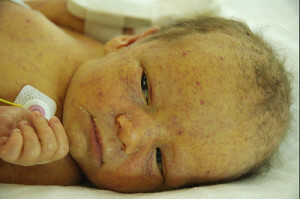 Over time, serious pathologies such as
Over time, serious pathologies such as
- can occur;
- deafness;
- atrophy of the optic nerve on the background of chorioretinitis;
- decreased intelligence( with CNS damage).
Treatment of cytomegalovirus infection
Treatment of CMV is generally ineffective.The complete destruction of the virus is not a question, but the activity of cytomegalovirus can be greatly reduced with the help of modern drugs.
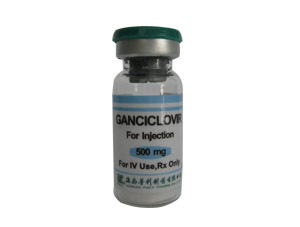 Antiviral drug Ganciclovir is used to treat newborns for life.In adult patients, it is able to slow the development of retinal damage, but with lesions of the digestive, respiratory and central nervous system practically does not give a positive result.The abolition of this drug often leads to recurrence of cytomegalovirus infection.
Antiviral drug Ganciclovir is used to treat newborns for life.In adult patients, it is able to slow the development of retinal damage, but with lesions of the digestive, respiratory and central nervous system practically does not give a positive result.The abolition of this drug often leads to recurrence of cytomegalovirus infection.
One of the most promising tools for CMV therapy is Foscarnet.The use of a specific hyperimmune immunoglobulin may be indicated.Interferons also help the body to cope faster with cytomegalovirus.
A successful combination is Acyclovir + A-interferon.Ganciclovir is recommended to be combined with Amiksin.
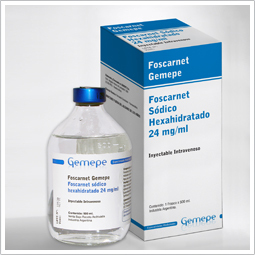
Konev Alexander, the therapist



